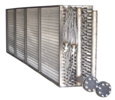Decoding HVAC Coil Industry Abbreviations and Formulas

In the HVAC coil industry, even a seasoned coil professional might run across a new abbreviation or formula. Here are the answers to some Frequently Asked Questions:
Q: What does BTU stand for?A: British Thermal Unit
Q: What does CFM stand for?A: Cubic Feet per Minute
Q: What does GPM stand for?A: Gallons per Minute
Q: What does PSI stand for?A: Pounds per Square Inch
Q: What measurement unit is used for Tube Velocity?A: Feet per Second (FPS)
Q: What measurement unit is used for a drop in air pressure?A: Inches of Water Gauge (W.G.)
Q: How is Face Velocity measured?A: Face Velocity is the air velocity at the hood or slot opening, measured in Feet per Minute (FPM).
Q: What is the difference between Dry Bulb, Wet Bulb and Dew Point temperature?A: Dry Bulb temperature is also called air temperature and can be measured with a thermometer. Wet Bulb temperature is the temperature of adiabatic saturation and can be measured by wrapping wet muslin around the bulb of a thermometer. Dew Point is the temperature at which water vapor starts to condense out of the air, when the air becomes completely saturated.
Q: What is a Psychrometric Chart?A: A psychrometric chart presents physical and thermal properties of moist air in a graphical form. http://web.uconn.edu/poultry/NE-127/NewFiles/psychrometric_inset.html
Q: What is a Reynolds Number?A: The Reynolds Number (Re) is the ratio of inertial resistance to viscous resistance for a flowing fluid.
Q: What is Sensible Heat?A: Sensible heat results in a temperature change of a substance that can be seen on a thermometer. Sensible heat can either be added or removed. For example, heating air with a hot water coil will cause the temperature to rise.
Q: What is Latent Heat?A: Latent heat, results in a change of state with no change in temperature of that substance. As with Sensible Heat, Latent Heat can either be added or removed. For example, a latent cooling load occurs when water vapor is condensed, causing a change in the moisture content or relative humidity of the air.
Q: What is Total Heat?A: Total Heat is the sum of the Sensible Heat and Latent Heat portions of the evaporator load.
Q: How do you convert Steam PSI into degrees Fahrenheit?A: There are formulas to use or you can refer to charts such as this one: http://www.jgbhose.com/technical-reference-literature/steam-temperature-pressure-conversion-guide.asp
